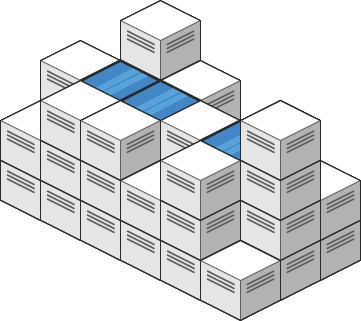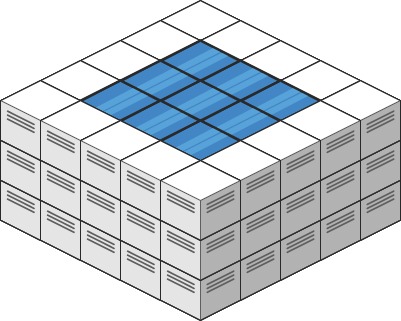【LeetCode】接雨水 II [H](堆)
LeetCode II
2023-09-27 14:19:52 时间
一、题目
给你一个 m x n 的矩阵,其中的值均为非负整数,代表二维高度图每个单元的高度,请计算图中形状最多能接多少体积的雨水。
示例 1:

输入: heightMap = [[1,4,3,1,3,2],[3,2,1,3,2,4],[2,3,3,2,3,1]]
输出: 4
解释: 下雨后,雨水将会被上图蓝色的方块中。总的接雨水量为1+2+1=4。
示例 2:

输入: heightMap = [[3,3,3,3,3],[3,2,2,2,3],[3,2,1,2,3],[3,2,2,2,3],[3,3,3,3,3]]
输出: 10
提示:
- m == heightMap.length
- n == heightMap[i].length
- 1 <= m, n <= 200
- 0 <= heightMap[i][j] <= 2 * 104
二、代码
class Solution {
class Node {
// 坐标
public int x;
public int y;
// 该位置的的高度
public int value;
public Node(int x, int y, int value) {
this.x = x;
this.y = y;
this.value = value;
}
}
public int trapRainWater(int[][] heightMap) {
// 小根堆
PriorityQueue<Node> heap = new PriorityQueue<>((a, b) -> a.value - b.value);
// 矩阵的行数
int n = heightMap.length;
// 矩阵的列数
int m = heightMap[0].length;
// 内弧的瓶颈
int max = 0;
// 标志当前位置是否已经加入到过小根堆,true表示已经加入过小根堆
boolean[][] isVisited = new boolean[n][m];
// 先将矩阵的四周的都加入到堆中,四周一定是存不下水的
for (int i = 0; i < m; i++) {
heap.add(new Node(0, i, heightMap[0][i]));
isVisited[0][i] = true;
}
for (int i = 1; i < n; i++) {
heap.add(new Node(i, m - 1, heightMap[i][m - 1]));
isVisited[i][m - 1] = true;
}
for (int i = m - 2; i >= 0; i--) {
heap.add(new Node(n - 1, i, heightMap[n - 1][i]));
isVisited[n - 1][i] = true;
}
for (int i = n - 2; i >= 1; i--) {
heap.add(new Node(i, 0, heightMap[i][0]));
isVisited[i][0] = true;
}
// 记录总的水量
int water = 0;
while (!heap.isEmpty()) {
// 将堆顶弹出
Node cur = heap.poll();
int row = cur.x;
int col = cur.y;
// 用堆顶尝试更新瓶颈Max
max = Math.max(max, cur.value);
// 将弹出位置的上、下、左、右还没有加入过堆的位置加入到堆中,同时结算加入堆的位置的水量
if (row > 0 && !isVisited[row - 1][col]) {
heap.add(new Node(row - 1, col, heightMap[row - 1][col]));
isVisited[row - 1][col] = true;
water += (Math.max(0, max - heightMap[row - 1][col]));
}
if (row < n - 1 && !isVisited[row + 1][col]) {
heap.add(new Node(row + 1, col, heightMap[row + 1][col]));
isVisited[row + 1][col] = true;
water += (Math.max(0, max - heightMap[row + 1][col]));
}
if (col > 0 && !isVisited[row][col - 1]) {
heap.add(new Node(row, col - 1, heightMap[row][col - 1]));
isVisited[row][col - 1] = true;
water += (Math.max(0, max - heightMap[row][col - 1]));
}
if (col < m - 1 && !isVisited[row][col + 1]) {
heap.add(new Node(row, col + 1, heightMap[row][col + 1]));
isVisited[row][col + 1] = true;
water += (Math.max(0, max - heightMap[row][col + 1]));
}
}
// 返回总水量
return water;
}
}三、解题思路
整个流程就还是按照求瓶颈的思想来结算水量,具体的流程在代码注释中。
用堆的作用就是保证从小到大开始处理,这样能将max内弧中的数全都结算完水量(该内弧中所有小于max的数),再去更新更大的max,去结算新的内弧水量,避免数据遗漏。
如果此时小根堆里最小值都超过max了,那么说明此时小根堆里的所有值都超过max了,也就是此时已经来到了一个全新的内弧了,不再是以前那个max作为瓶颈的内弧了,现在遍历来到了一个全新的内弧。
相关文章
- Leetcode: Repeated String Match
- Leetcode: Add Two Numbers II
- Leetcode: Minimum Moves to Equal Array Elements II
- leetcode笔记:Ugly Number II
- LeetCode——Remove Duplicates from Sorted List II
- 【Leetcode】98. 验证二叉搜索树(中等)
- [LeetCode] Populating Next Right Pointers in Each Node II
- [LeetCode] Spiral Matrix II
- [LeetCode] Search in Rotated Sorted Array II
- [LeetCode]1342. 将数字变成 0 的操作次数
- 153、【动态规划】leetcode ——1049. 最后一块石头的重量 II:滚动数组(C++版本)
- 71、【哈希表】leetcode——350. 两个数组的交集 II(C++版本)
- 【LeetCode】154. Find Minimum in Rotated Sorted Array II (3 solutions)
- 【leetcode】103:二叉树的锯齿形层序遍历
- 【Leetcode】28: 实现 strStr()
- [LeetCode] 1184. Distance Between Bus Stops 公交站间的距离
- [LeetCode] 1162. As Far from Land as Possible 地图分析
- [LeetCode] 1111. Maximum Nesting Depth of Two Valid Parentheses Strings 有效括号的嵌套深度
- [LeetCode] 776. Split BST 分割二叉搜索树
- [LeetCode] Implement Magic Dictionary 实现神奇字典
- [LeetCode] Longest Uncommon Subsequence II 最长非共同子序列之二
- [LeetCode] 352. Data Stream as Disjoint Intervals 分离区间的数据流
- [LeetCode] 229. Majority Element II 求大多数之二
- [LeetCode] 90. Subsets II 子集合之二
- leetcode 503. Next Greater Element II 下一个更大元素 II(中等)
- leetcode 167. Two Sum II - Input Array Is Sorted 两数之和 II - 输入有序数组

